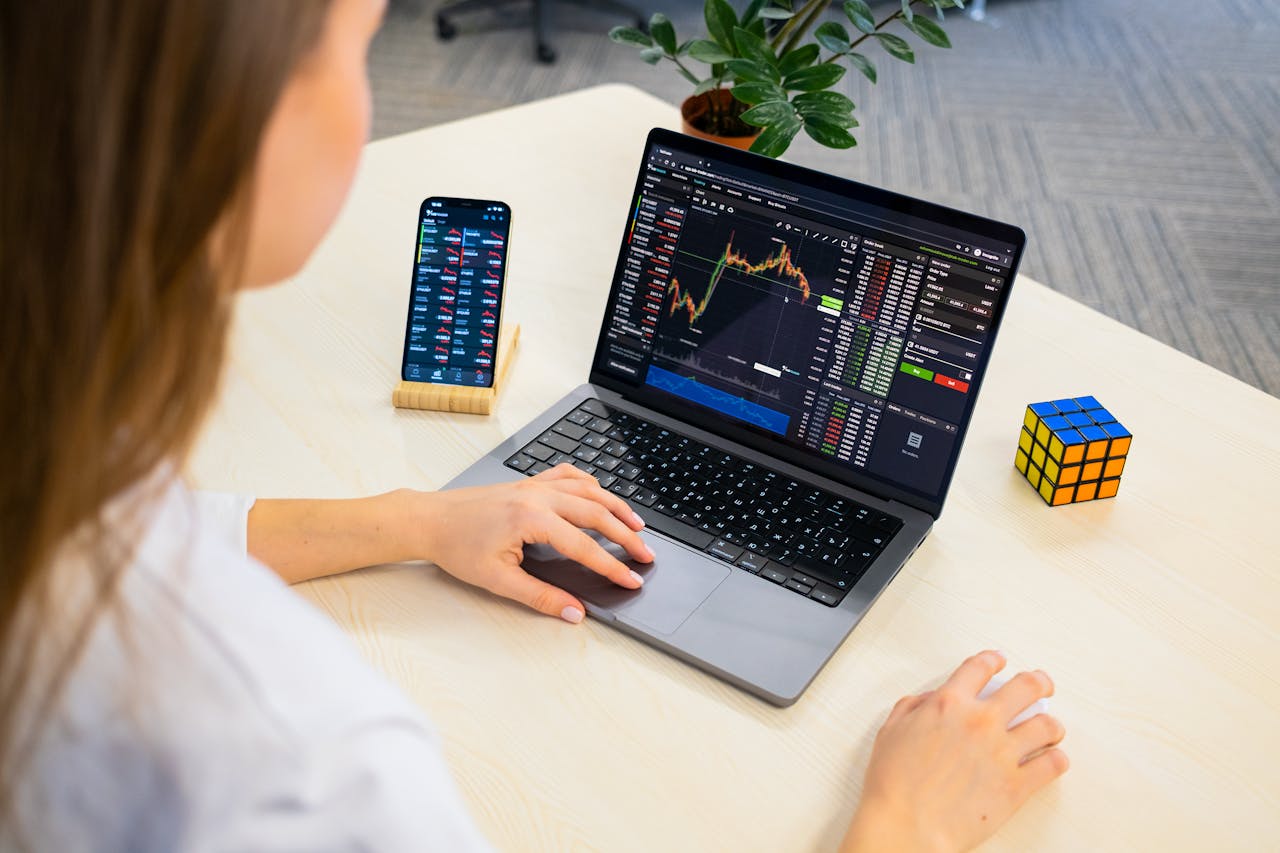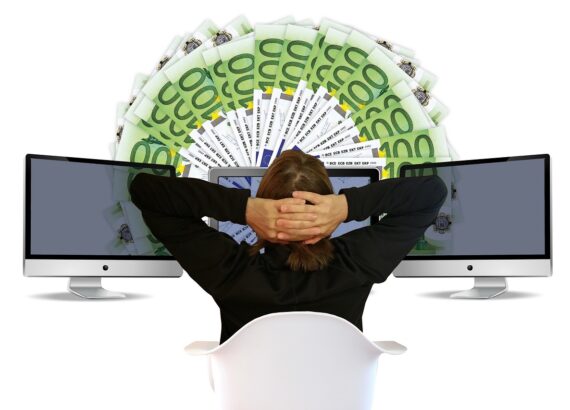
Unlock the Secrets of ETFs: The Investment Strategy Everyone’s Talking About!
Affiliate links may be used in this post. I may receive a small commission at no extra cost to you if you make a purchase through my affiliate link. Read my full disclosure policy here.
What is an ETF? A Simple Investment Tool Explained
An Exchange-Traded Fund (ETF) is a type of investment fund that offers investors a way to buy a collection of assets, such as stocks, bonds, or commodities, in a single package. Unlike mutual funds, which are bought and sold only at the end of the trading day, ETFs are traded on stock exchanges, meaning they can be bought and sold throughout the day, just like individual stocks.
How ETFs Work: Building a Portfolio in One Move
When you invest in an ETF, you are essentially buying a small portion of all the underlying assets the fund holds. For example, an ETF might invest in hundreds of stocks across different industries, or it might focus on a specific sector, such as technology or healthcare. Some ETFs also invest in bonds, commodities (like gold or oil), or other assets like real estate.
The primary appeal of ETFs lies in their simplicity and flexibility. They allow investors to diversify their portfolios easily and at a lower cost compared to other investment options like mutual funds or individual stock-picking.

Exploring Different Types of ETFs: Finding Your Niche
Stock ETFs: These track a basket of company stocks. For example, the S&P 500 ETF invests in the 500 largest publicly traded companies in the U.S.
Bond ETFs: These track different types of bonds, such as government, corporate, or municipal bonds.
Sector or Industry ETFs: These focus on specific industries, like technology, healthcare, or energy.
Commodity ETFs: These track physical commodities like gold, oil, or agriculture products.
International ETFs: These provide exposure to markets outside of your home country. For instance, there are ETFs that focus on European, Asian, or emerging markets.
Thematic ETFs: These focus on a specific theme, such as clean energy, robotics, or artificial intelligence.
Inverse and Leveraged ETFs: These are more complex and are designed to amplify returns or profit from market declines. They carry higher risk and are generally suited for short-term trading.
Why ETFs Should Be in Your Portfolio: Key Benefits
Diversification: By investing in an ETF, you gain exposure to a broad range of assets, which can help reduce risk. Instead of picking individual stocks, ETFs allow you to own a portfolio of assets with a single purchase. This is especially helpful for small investors who may not have the funds to buy many individual stocks.
Cost-Efficiency: ETFs are known for their low expense ratios. Since many ETFs are passively managed (tracking a specific index like the S&P 500 or the Nasdaq), the management fees are typically lower than actively managed mutual funds, where managers actively select and trade investments.
Liquidity: Since ETFs trade on stock exchanges, you can buy or sell shares at any time during market hours. This provides liquidity and flexibility, unlike mutual funds, which only settle trades once per day after the market closes.
Transparency: Most ETFs disclose their holdings on a daily basis, allowing investors to know exactly what assets they are investing in. This is a key difference from mutual funds, which typically disclose holdings on a quarterly basis.
Tax Efficiency: ETFs tend to be more tax-efficient than mutual funds because of the way they are structured. They generally do not distribute capital gains to shareholders as frequently, which reduces the tax liability for investors.
Flexibility: ETFs are highly flexible as they allow you to invest in specific sectors, regions, or asset classes. For example, if you believe technology stocks will perform well, you could invest in a tech-focused ETF. Or if you want to hedge against inflation, you could buy a commodities ETF like one that tracks gold.

Investing in ETFs: Where Do You Start?
- Buying ETFs is simple: You can purchase ETFs through most brokerage accounts, similar to how you would buy stocks. Some brokers even offer commission-free trading for certain ETFs.
- Consider your goals: Before investing, think about what kind of exposure you want. Are you looking for a broad market index like the S&P 500? Or are you interested in a more niche sector or asset class?
- Watch out for costs: While ETFs generally have lower fees than mutual funds, some may still have higher expense ratios, particularly specialized ETFs. Always check the cost structure of the ETF you’re considering.
Understanding the Risks: What to Watch Out for with ETFs
Like any investment, ETFs come with risks. The value of an ETF can go up or down based on the performance of the underlying assets. Market volatility, sector performance, and global events can all impact an ETF’s price. Leveraged or inverse ETFs are particularly risky as they amplify gains and losses.
Additionally, some niche or thematic ETFs may have a higher risk profile due to their concentration in a single sector or industry. For example, an ETF focused on a new technology or a specific country might experience more volatility.
Conclusion: The Power of ETFs in Building Long-Term Wealth
ETFs are an efficient and cost-effective way for investors to gain exposure to a diversified portfolio of assets. Whether you’re a beginner or a seasoned investor, ETFs can fit into almost any investment strategy. They offer a blend of flexibility, transparency, and low costs, making them an attractive option for building long-term wealth.
With the growing popularity of ETFs, there is now an ETF for almost every investing need, from broad-market funds to those that track specific sectors or themes. Understanding how they work and their potential risks and rewards can help you make informed investment decisions.
Step 1: Choose a reputable investment platform
Before you can start investing in ETFs, you need a platform where you can buy and sell them. There are many reliable and established platforms available, depending on where you live. Below are a few highly-rated options for both UK and US investors.
Investment Platforms for UK Investors:
-
Hargreaves Lansdown
- One of the largest and most trusted investment platforms in the UK, offering a wide range of ETFs, stocks, and other investment products. It’s user-friendly and has great customer service.
- Fees: Slightly higher fees than some competitors, but they offer comprehensive research and support.
-
AJ Bell
- A cost-effective platform with a wide variety of ETFs available. It’s a good choice for those looking for lower fees and a simple user experience.
- Fees: Competitive annual fees and low trading costs.
-
Fidelity International
- Another well-regarded platform in the UK, with a wide range of funds and ETFs. They offer educational resources for beginners.
- Fees: Moderate fees with no charge for buying ETFs.
-
Vanguard UK
- Known for their low-cost ETF options, Vanguard is great for investors looking for a long-term strategy. Vanguard offers its own suite of ETFs, focused on low fees and broad diversification.
- Fees: Some of the lowest fees in the industry, but limited to Vanguard’s products.
Investment Platforms for US Investors:
-
Fidelity Investments
- A popular platform in the US known for its no-fee ETFs, commission-free trading, and excellent research tools.
- Fees: No commission on most ETFs and very low fees on their own funds.
-
Charles Schwab
- Offers a wide range of ETFs with commission-free trades and educational tools, making it a great choice for both beginners and experienced investors.
- Fees: No commission on many ETFs and low management fees.
-
Vanguard US
- Similar to its UK counterpart, Vanguard is a great option for long-term, low-cost ETF investing in the US. Their platform is focused on making investing simple and accessible.
- Fees: Some of the lowest fees, with a focus on index-based ETFs.
-
Robinhood (US)
- A mobile-first platform that offers commission-free trading, including ETFs. Robinhood is popular with beginner investors for its ease of use and no account minimums.
- Fees: No trading fees, though there may be fees tied to the ETFs themselves.

Step 2: Start Small - You Don't Need a lot to Invest
One of the best things about investing in ETFs is that you don’t need a large amount of money to get started. Many platforms allow you to buy fractional shares, meaning you can purchase a small portion of an ETF, even if the full share price is high.
How to Get Started with Minimal Investment:
Low Minimum Investment: Many platforms, like Vanguard, Fidelity, and Robinhood, let you start investing with very little money. Some platforms don’t require a minimum investment at all, meaning you can begin with as little as $10 or £10.
Fractional Shares: Platforms like Robinhood (US) and AJ Bell (UK) allow you to invest in fractional shares of ETFs. For example, if an ETF share costs $300, you can buy just a small portion of it based on how much money you have available.
Commission-Free ETFs: Look for platforms offering commission-free trading, like Fidelity or Charles Schwab, so you don’t lose any of your initial investment to trading fees.
Automating Your Investments:
Some platforms, such as Vanguard and Fidelity, also offer automatic investment plans. This allows you to set up a recurring deposit (like £50 or $50 per month), which can help you gradually build your ETF portfolio over time without needing to worry about timing the market.
Step 3: Before You Start Investing
Before diving into the world of ETFs, it’s important to take some time to evaluate your financial goals, risk tolerance, and the kind of assets you want to invest in. This step will guide you through setting a solid foundation for your investment journey.
1. Find Your Long-Term Goal: Why Are You Investing?
The first step is to clearly define your **investment goal**. Ask yourself: **Why do you want to invest?** Are you saving for retirement, buying a house, or building wealth over time? Setting a clear goal will help you decide on the right strategy and guide your investment decisions.
– **How much can you afford to invest?** Start by determining how much you can comfortably set aside for investing after covering your daily expenses and emergency savings. You don’t need to have a lot of money to begin. Even small, consistent investments can grow significantly over time.
– **Investment Horizon**: Knowing how long you plan to keep your money invested (5, 10, or 20+ years) will influence the type of ETFs you choose. Longer investment horizons often allow for more risk, while short-term goals may require safer, less volatile option.
2. Understand Your Risk Tolerance
Your **risk tolerance** refers to how comfortable you are with the ups and downs of the market. Some investments are riskier than others, so it’s essential to know how much risk you can handle before choosing ETFs.
**High Risk Tolerance**: If you are comfortable with market fluctuations and the possibility of losing some of your investment in the short term, you might opt for **equity ETFs** that focus on stocks, which typically offer higher potential returns but with more volatility.
**Low Risk Tolerance**: If you prefer a more stable investment that prioritizes capital preservation, **bond ETFs** or **commodity ETFs** (like gold) might be more suitable. These options tend to have lower risk but also lower returns.
Your **age** also plays a role here. Younger investors often have a higher risk tolerance because they have more time to recover from market downturns, while older investors nearing retirement may prioritize stability and capital preservation.
Related Article: Understanding Risk Appetite: Find Your Perfect Investment
3. Decide What Asset Classes You Want to Invest in
ETFs offer exposure to a wide range of **asset classes**. Understanding the differences between them is crucial in creating a balanced portfolio that matches your risk tolerance and financial goals.
**Equity ETFs**: These invest in stocks and are ideal for long-term growth, though they come with higher volatility.
**Bond ETFs**: These focus on fixed-income assets, like government or corporate bonds, and are generally considered lower-risk.
**Commodity ETFs**: Invest in physical goods like gold, oil, or agricultural products. These can be a hedge against inflation or market downturns.
**Real Estate ETFs (REITs)**: Offer exposure to real estate markets without the need to own physical property.
**Multi-Asset ETFs**: Some ETFs blend different asset classes, such as a combination of stocks, bonds, and commodities, to create a diversified portfolio within a single product.
The asset class you choose should reflect your investment goals and risk tolerance. For example, if you’re younger and focused on long-term growth, you may want to lean more heavily into equity ETFs. If you’re looking for stability, bonds and commodities might play a bigger role in your portfolio.
4. Choose a Diversification Strategy: Global or Focused?
Decide how **diversified** you want your investments to be. Diversification spreads your money across different markets, reducing the risk that any one company, sector, or region can negatively impact your entire portfolio.
**Global Diversification**: Some ETFs offer exposure to **global markets**, investing in companies from various countries and sectors. This can provide stability because it spreads risk across multiple regions. Global ETFs are great for investors who want to minimize risk by not being overly reliant on the performance of one country or region.
**Narrow Focus**: Alternatively, you may want to focus on a specific country (like the UK or US), sector (like technology, healthcare, or energy), or theme (like clean energy or artificial intelligence). While these can provide higher returns, they often come with more risk due to limited diversification.
Your diversification strategy will depend on your personal goals and risk appetite. A mix of global and focused ETFs can provide the best of both worlds.
5. Research and Get a Feel for the Market
Before making any investments, it’s essential to do some **research** to understand what’s out there. Familiarize yourself with different ETFs, asset classes, and sectors. There are several tools and resources that can help:
**ETF Screeners**: Use tools like those provided by **Morningstar**, **Yahoo Finance**, or your investment platform to search for ETFs based on specific criteria like performance, expense ratio, or asset class.
**Financial News and Market Trends**: Stay up to date on market news, global economic conditions, and trends in the industries you’re considering. For example, a growing interest in clean energy may make renewable energy ETFs an attractive option.
**Performance History**: While past performance isn’t a guarantee of future returns, reviewing an ETF’s history can give you an idea of how it has performed over different market conditions.
Doing your homework will help you feel more confident in your investment choices and ensure that you’re picking ETFs that align with your long-term goals.
By carefully considering these factors before investing, you’ll be better prepared to choose ETFs that fit your needs and build a diversified, resilient portfolio. With clear goals, an understanding of risk, and a thoughtful diversification strategy, you can start investing with confidence—even if you’re starting small.

Exploring ETFs Step By Step
Once you’ve defined your goals and chosen a platform, the next step is to research specific ETFs. A great tool for this is the website JustETF, which provides detailed information about a wide variety of ETFs available for different markets and asset classes. Below, I’ll walk you through the process of researching ETFs using the platform.
1. Start by Visiting JustETF
Head to the ETF Screener tool. This tool allows you to filter and search for ETFs based on specific criteria like asset class, region, or sector.
2. Set Your Search Criteria
On the ETF screener page, you’ll see various options for filtering your search. You can choose criteria based on:
- Asset Class: Whether you’re looking for equity, bonds, commodities, or a mix.
- Region: If you want to invest globally or in specific regions like Europe, Asia, or the US.
- Sector: Narrow your focus to specific industries like technology, healthcare, or energy.
- Theme: If you’re interested in particular themes like clean energy, emerging markets, or artificial intelligence.
Once you’ve selected your preferred criteria, click Search to get a list of ETFs that match your preferences.
3. Review the ETF List
JustETF will generate a list of ETFs based on your chosen filters. The list will include key details such as:
- ETF Name: The name and description of the ETF.
- Ticker Symbol: The ETF’s stock exchange code.
- Expense Ratio: The annual cost of managing the ETF.
- Performance: Historical returns over different time periods (1 year, 3 years, 5 years, etc.).
- Fund Size: The total amount of assets managed by the ETF.
This list gives you an overview of all the ETFs that fit your criteria, helping you compare options at a glance.
4. Dive Deeper into a Specific ETF
To get detailed information about a specific ETF, simply click on the name of the ETF. This will take you to the ETF profile page, where you can see comprehensive data, including:
- Fund Objectives: What the ETF aims to achieve (e.g., track a specific index or sector).
- Top Holdings: A breakdown of the largest investments in the ETF.
- Dividend Information: Whether the ETF pays out dividends and, if so, how often.
- Risk Level: The risk profile of the ETF, helping you understand whether it aligns with your risk tolerance.
- Performance Data: Detailed historical performance, showing how the ETF has performed in different market conditions.
This information is crucial for evaluating whether the ETF matches your investment strategy and risk tolerance.
5. Save or Bookmark Your Favorite ETFs
Once you’ve found a few ETFs that fit your investment goals, you can save or bookmark them for easy reference. Many platforms, including JustETF, allow you to create a watchlist where you can track ETFs and monitor their performance over time.
By using the JustETF platform, you can conduct thorough research and find ETFs that align with your goals, risk tolerance, and diversification strategy. It’s an invaluable tool to ensure that you make informed investment decisions.

Key ETF Terms Every Investor Should Know
When you start researching ETFs, you’ll come across some financial terms that may seem confusing at first. Here’s a breakdown of the most common ones and how they impact your investment decisions.
1. Ticker Symbol
A ticker symbol is a unique code assigned to an ETF (or any other stock) that represents it on the stock exchange. It usually consists of a few letters and helps investors easily identify the ETF they want to buy or track. For example:
- VUSA: Vanguard S&P 500 UCITS ETF (tracks the S&P 500 Index)
- IWDA: iShares MSCI World UCITS ETF (tracks global markets)
- GLD: SPDR Gold Shares (tracks the price of gold)
When you’re ready to invest in an ETF, you’ll use this symbol to find it on your investment platform.
2. Expense Ratio (Also Called Management Fee)
The expense ratio is the annual fee that the ETF provider charges to manage the fund. It is expressed as a percentage of your total investment. For example, an expense ratio of 0.20% means that for every £1,000 you invest, you’ll pay £2 annually in fees.
- What is a good expense ratio? Low-cost ETFs usually have expense ratios below 0.50%, which is considered a good rate. In fact, many ETFs charge 0.10%–0.30%, especially for large, well-established funds.
- What to avoid? Be cautious with ETFs that have high expense ratios, typically above 1%. High fees can eat into your returns over time, especially for long-term investments.
3. Past Performance vs. Future Results
You’ll often see data showing how an ETF has performed in the past, but it’s important to remember that past performance does not guarantee future results. An ETF might have done well over the past 5 years, but that doesn’t mean it will continue to grow at the same rate. Markets change, and unforeseen events can impact performance.
4. Fund Size
The fund size is the total amount of assets that the ETF manages. Larger ETFs, with billions in assets, tend to be more stable and liquid (easier to buy and sell). Smaller ETFs, especially those with less than $100 million, can carry more risk because:
- They may be more expensive to trade due to lower liquidity.
- There’s a chance that the fund could close if it doesn’t attract enough investors.
Also, if the ETF has only been on the market for a short time, it doesn’t have a long track record, making it harder to predict how it might perform over different market conditions.
5. How to Know if an ETF Pays Dividends
Not all ETFs pay dividends, but if you’re looking for income, you’ll want to find an ETF that distributes dividends. On the ETF profile page (like on JustETF or Yahoo Finance), you can see if it pays dividends under the “dividend yield” section. The dividend yield is shown as a percentage, indicating how much the ETF pays in dividends relative to its current price.
- For example, a 2% dividend yield means that for every £100 you invest, you’ll receive £2 annually in dividends.
6. Risk Level
Every ETF has a risk level, which is usually represented on a scale from 1 to 7, with 1 being the lowest risk and 7 being the highest. This rating helps you understand how volatile (how much the price goes up and down) the ETF is. Higher-risk ETFs (6 or 7) often invest in stocks or sectors that can be more volatile, while lower-risk ETFs (1 or 2) usually focus on stable assets like bonds or larger, established companies.
- Low-Risk ETF (1–3): Suitable for conservative investors who prefer stability over high returns (e.g., bond ETFs).
- High-Risk ETF (5–7): Suitable for investors willing to take on more volatility for higher potential returns (e.g., emerging market ETFs, tech sector ETFs).
7. P/E Ratio (Price-to-Earnings Ratio)
The P/E ratio tells you how much investors are willing to pay for every £1 of a company’s earnings. It’s a common way to evaluate whether an ETF is overvalued or undervalued.
- A high P/E ratio (e.g., 30+) means investors are paying a premium, expecting high growth.
- A low P/E ratio (e.g., 10–15) means the ETF could be undervalued, or it may be invested in slower-growth industries.
For example, if an ETF’s P/E ratio is 25, it means that for every £1 of earnings, investors are willing to pay £25. Comparing the P/E ratios of different ETFs can help you understand the relative value of the sectors or markets they focus on.
8. Price per Share
The price per share is the current market value of one share of the ETF. It fluctuates throughout the trading day based on supply and demand. Some ETFs have a higher share price, but you don’t need to buy a full share—you can purchase fractional shares on many platforms, meaning you can invest with small amounts of money.
Key Terms To Be aware of.....
Aou’ve covered a lot of the essential ETF concepts already, but here are a few additional terms and concepts that could further enhance your guide and provide more value to your readers:
1. Tracking Error
- What it is: The difference between the performance of the ETF and the index or benchmark it’s designed to track. Ideally, an ETF should closely follow the performance of its benchmark, but due to fees, market conditions, or how the fund is managed, its returns might differ slightly.
- Why it’s important: A small tracking error (close to 0%) indicates the ETF is doing a good job of replicating the performance of its underlying index. A large tracking error suggests the ETF might not be performing as expected.
2. Bid-Ask Spread
- What it is: The bid is the highest price a buyer is willing to pay for an ETF, and the ask is the lowest price a seller is willing to accept. The spread is the difference between the two.
- Why it’s important: A narrower bid-ask spread means the ETF is more liquid and easier to trade. A wider spread could mean higher trading costs, especially for smaller or less frequently traded ETFs. Always look for ETFs with a smaller spread, especially if you plan to trade frequently.
3. Accumulating vs. Distributing ETFs
- What it is: Some ETFs automatically reinvest dividends back into the fund (accumulating ETFs), while others pay them out to investors (distributing ETFs).
- Why it’s important: If you’re looking to grow your investment over the long term, accumulating ETFs can be a great option because dividends are automatically reinvested. However, if you prefer to receive regular income, you might want to opt for a distributing ETF that pays out dividends periodically.
4. Total Return vs. Price Return
- Total Return: This includes the price change of the ETF as well as dividends and interest payments.
- Price Return: Only reflects the change in the ETF’s price, not any dividends or interest.
- Why it’s important: Always check whether you’re looking at total return (which gives a fuller picture of performance) or price return (which could miss the income component of the ETF).
5. ETF Liquidity
- What it is: ETF liquidity refers to how easily you can buy or sell shares of the ETF without significantly affecting the price.
- Why it’s important: Even if an ETF has low trading volume, its liquidity is also impacted by the liquidity of the underlying assets it holds. Highly liquid ETFs with lots of daily trading volume are easier and cheaper to buy and sell.
6. Synthetic vs. Physical ETFs
- Physical ETFs: These directly own the underlying assets, like stocks or bonds.
- Synthetic ETFs: These replicate the performance of an index using derivatives, such as swaps.
- Why it’s important: Physical ETFs are generally considered safer because they hold the actual assets. Synthetic ETFs can sometimes carry additional risks due to their use of derivatives, though they might offer lower costs or access to markets that are hard to replicate physically.
7. ETF Tax Implications
- Why it’s important: Depending on your country (UK, US, etc.), different tax rules apply to ETFs. For example, in the UK, you can shelter your ETF investments in an ISA or SIPP to avoid paying taxes on capital gains and dividends. It’s worth mentioning that tax-efficient investing is a key strategy for maximizing returns.
8. Rebalancing and ETF Management Style
- Active vs. Passive ETFs:
- Passive ETFs track an index (like the S&P 500) and simply aim to replicate its performance.
- Active ETFs are managed by a team that makes decisions on what to buy and sell with the goal of outperforming the market.
- Why it’s important: Passive ETFs tend to have lower fees and are generally better for long-term, hands-off investing. Active ETFs, while offering the potential for higher returns, usually come with higher fees and can carry more risk if the manager’s strategy doesn’t work out.
9. ETF Turnover Ratio
- What it is: The turnover ratio measures how often the assets in the ETF are bought and sold.
- Why it’s important: A high turnover ratio might indicate more frequent trading, which could lead to higher costs (like transaction fees) and more tax consequences for investors. Lower turnover generally means fewer trades, lower costs, and less tax liability.
10. Currency Risk
- What it is: If you’re investing in ETFs that hold foreign assets, your returns can be impacted by changes in currency exchange rates.
- Why it’s important: Currency-hedged ETFs are available to protect against fluctuations in foreign currencies. These may be useful if you’re investing in international ETFs but want to avoid the risk that currency movements will erode your returns.

Ready To Start Your ETF Journey?
Investing in ETFs doesn’t have to be overwhelming. By understanding the key concepts, setting clear goals, and choosing the right platforms, you’re already well on your way to building a solid investment strategy. Remember, the earlier you start, the more time your investments have to grow.
But don’t stop here! To make the most of your investment journey, it’s important to regularly assess your strategy, refine your goals, and stay informed about the market.
Get Your Free ETF Investment Workbook!
To help you dive even deeper into ETF investing and put your knowledge into practice, I’ve created a FREE ETF Investment Workbook. It’s filled with guided questions, checklists, and resources to help you:
- Define your long-term financial goals
- Identify your risk tolerance
- Research and choose ETFs that fit your strategy
- Track your investments over time
Download your FREE workbook now and take the first step toward becoming a confident ETF investor!



Comments (2)
Elisa
September 18, 2024 at 5:36 pm
You have some great tactics and strategies that people would love!
monmon
October 10, 2024 at 10:00 pm
Thank you. I am hoping that more and more people will have fun investing.
Comments are closed